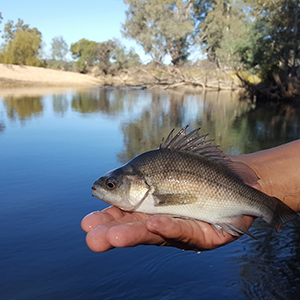Larval fish sensitivity to a simulated cold-water pulse varies between species and age

Accepted: 27 June 2022
Supplementary: 161
HTML: 135
All claims expressed in this article are solely those of the authors and do not necessarily represent those of their affiliated organizations, or those of the publisher, the editors and the reviewers. Any product that may be evaluated in this article or claim that may be made by its manufacturer is not guaranteed or endorsed by the publisher.
Authors
The release of cold-water from hypolimnetic zones of impoundments sharply reduces downstream riverine water temperature. This cold-water pollution (CWP) can extend for hundreds of kilometres, severely challenging the physiological ability of aquatic fauna, particularly ectotherms such as fish, to maintain essential processes such as metabolism, development and growth and survival. The impact of CWP on native fish, especially early life stages, is poorly known. We investigated the effect of a 24-hour exposure to a range of environmentally-related water temperatures (8, 10, 12, 14, 16, 18 and 20°C) on three age-classes (<24-hour-old, 7-day and 14-day-old larvae) of two Australian native fish species: Murray cod (Maccullochella peelii) and Macquarie perch (Macquaria australasica). Overall, larvae of M. peelii were more sensitive to lower water temperatures and hence CWP than M. australasica, indicated by higher rates of equilibrium loss. Larvae of M. peelii were most sensitive to exposure at seven days old whereas M. australasica larvae were most sensitive at <24-h-old. Using our results, we modelled pre- and post-impoundment temperature scenarios and estimated the downstream CWP footprint for both species in an Australian river reach. Larvae of M. peelii were predicted to be absent from the first 26 km of river downstream of the impoundment compared with no impact on the distribution of M. australasica. Managing riverine water temperature below impoundments is fundamental to promoting positive outcomes for endemic fish on not only a local, but global basis. This study emphasises the differential impact of CWP among the critical early life stages and fish species and highlights the urgent need to better manage hypolimnetic water releases to improve downstream river ecosystems.
Edited by
Pietro Volta, CNR-IRSA Verbania, ItalyHow to Cite

This work is licensed under a Creative Commons Attribution-NonCommercial 4.0 International License.
Similar Articles
- Svein Birger WÆRVÅGEN, Jens Petter NILSSEN, Life histories and seasonal dynamics of common boreal pelagic copepods (Crustacea, Copepoda) inhabiting an oligotrophic Fennoscandian lake , Journal of Limnology: Vol. 69 No. 2 (2010)
- Roman Baran, Michal Tušer, Helge Balk, Petr Blabolil, Martin Čech, Vladislav Draštík, Jaroslava Frouzova, Tomáš Jůza, Jan Kubecka, Quantification of Chaoborus and small fish by mobile upward-looking echosounding , Journal of Limnology: Vol. 78 No. 1 (2019)
- Cristiana CALLIERI, Gianluca CORNO, Emanuele CARAVATI, Silvia GALAFASSI, Michel BOTTINELLI, Roberto BERTONI, Photosynthetic characteristics and diversity of freshwater Synechococcus at two depths during different mixing conditions in a deep oligotrophic lake , Journal of Limnology: Vol. 66 No. 2 (2007)
- Valentina PIERI, Koen MARTENS, Luigi NASELLI-FLORES, Federico MARRONE, Giampaolo ROSSETTI, Distribution of Recent ostracods in inland waters of Sicily (Southern Italy) , Journal of Limnology: Vol. 65 No. 1 (2006)
- Armando BUFFONI, Ozone and nitrogen dioxide measurements in the framework of the National Integrated Programme for the Control of Forest Ecosystems (CONECOFOR) , Journal of Limnology: Vol. 61 No. s1 (2002): National Programme for Forest Ecosystems Control CONECOFOR
- Renato BAUDO, Anna OCCHIPINTI, Anna Maria NOCENTINI, Monica SABOLLA, Benthos of Lake Orta in the year 1996 , Journal of Limnology: Vol. 60 No. 2 (2001)
- Carla BONACINA, Lake Orta: the undermining of an ecosystem , Journal of Limnology: Vol. 60 No. 1 (2001)
- Milla RAUTIO, Sanna SORVARI, Atte KORHOLA, Diatom and crustacean zooplankton communities, their seasonal variability and representation in the sediments of subarctic Lake Saanajärvi , Journal of Limnology: Vol. 59 No. s1 (2000): Climatic variability and ecosystem dynamics at remote mountain lakes
- Jaromir Seda, Adam Petrusek, Daphnia as a model organism in limnology and aquatic biology: some aspects of its reproduction and development , Journal of Limnology: Vol. 70 No. 2 (2011)
- Angela Boggero, Silvia Zaupa, Simona Musazzi, Michela Rogora, Elzbieta Dumnicka, Andrea Lami, Environmental factors as drivers for macroinvertebrate and diatom diversity in Alpine lakes: New insights from the Stelvio National Park (Italy) , Journal of Limnology: Vol. 78 No. 2 (2019)
<< < 76 77 78 79 80 81 82 83 > >>
You may also start an advanced similarity search for this article.
-
John D. Koehn, Charles R. Todd, Henry Wootton, Michael JoyMarine and Freshwater Research : 2023

 https://doi.org/10.4081/jlimnol.2022.2056
https://doi.org/10.4081/jlimnol.2022.2056





